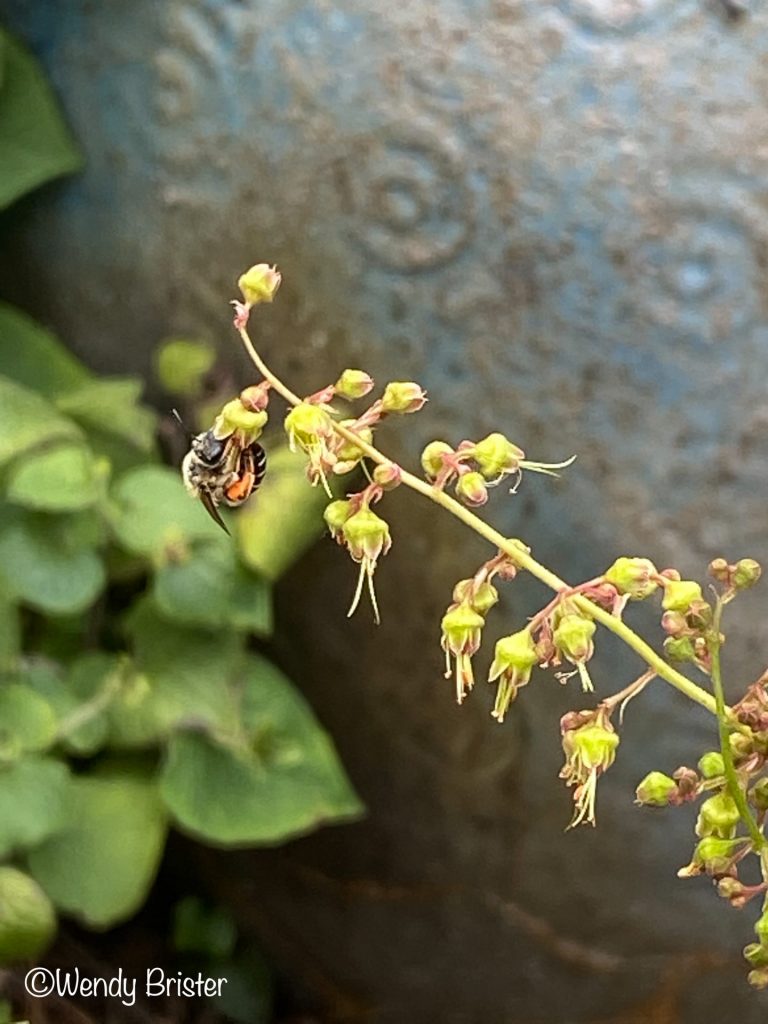A Native Plant Success Story: Finding Rare Bees in Your Backyard
Bees.

Depending on the audience, people love them or hate them. To some a ”bee“ is the pesky yellow jacket lingering on your soda can. To others, a “bee” is the honey bee, a European species known for iconic hives and honey production. Children often associate bees with painful stingers, while some adults worry about potentially deadly allergies.
To me, a “bee” is all of these things and none of them. I keep hives for honeybees, I get angered by the yellow buzzing things like yellow jackets (which in fact are not a true bee), and I thoroughly enjoy watching various native bumblebees as they visit the diverse flora in my backyard.
Watching these various bumblebees, as they collect yellow/gold pollen on their legs is what alerted me to something unusual a few weeks ago. A garden visitor hanging out on my native Heuchera americana or Coral Bells. However, this visitor was a bit different.

Smaller than a honeybee and carrying bright orange pollen on her back legs, the bee keeper in me wondered – “Where is she finding orange pollen this time of year?” Typically red-orange pollen is an early spring occurrence on honeybees – a sign that the henbit is in bloom. (Henbit, or Lamium amplexicaule, is a European annual that has naturalized in the United States.) This observation lead me to investigate further.
If you are familiar with Heuchera americana, you know that the flower is nothing exceptional, predominantly green and tiny. For many years I would cut them off because they would flop. However this year, they were standing tall, in a site with more sun exposure than normal due to a recent tree removal. I quickly ripped open one of the small green flowers to discover a surprise – orange pollen.
The next logical step was to take this recent finding to social media in search of an ID, being sure to tag Sam Droege, a Wildlife Biologist at the USGS Patuxent Wildlife Research Center in Laurel, MD. Within 8 days or sharing photographs, capturing samples and shipping them to a local entomologist (Shelby Kilpatrick, a PhD student at Penn State University) – we had a positive ID. A rare sighting of Colletes aestivalis, a pollen specialist bee on Heuchera americana, which had not been documented in Pennsylvania in 102 years.

My professional response to this was nothing other than “SQUEEEEEEE!!” What else can one say when you find a bee in your backyard that has not been documented in your state for 102 years?
Takeaway? Straight species native plants are important. Not only are there specialist bees for Heuchera, but there are specialist bees for Zizia, Asters, Goldenrods, Sunflowers, Coreopsis, Eupatorium, and so much more! Jarrod Fowler has compiled a great resource list of specialist bees and native hosts. What I have learned from this experience is that there are MANY unknowns when it comes to specialist bees. Will they collect pollen from cultivars of the straight species? This is something the scientists don’t have an answer for. Continued monitoring is needed and citizen scientists can play an important role in this monitoring.
What can you do? Plant Mid-Atlantic native plants in your garden in mass and watch! Take pictures of what you see and share with on facebook groups like Bee Inventory and Monitoring Lab (BIML), reach out to folks like Sam and Shelby, visit reputable websites and attend/listen to lectures when possible.